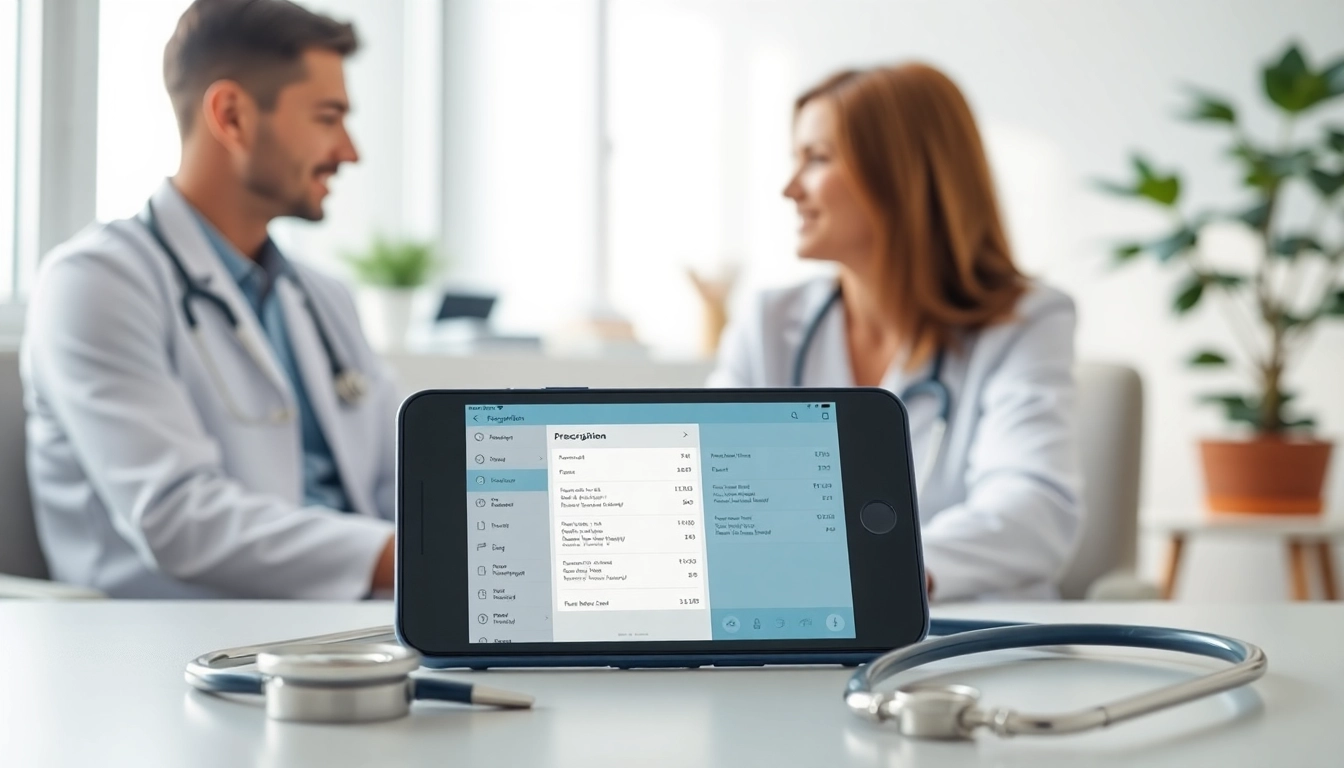Understanding Mobile Eprescription
What is Mobile Eprescription?
Mobile eprescription is a digital process that enables healthcare providers to generate and transmit prescriptions via mobile devices. This system offers a seamless and efficient method for patients to access their prescribed medications while simultaneously improving communication between healthcare providers and pharmacies. By utilizing mobile technology, eprescribing enhances both the patient experience and healthcare workflows, making it an essential part of modern healthcare practices.
How Mobile Eprescription Works
The mobile eprescription process begins when a healthcare provider writes a prescription using an application designed for mobile devices. This application pulls information from a patient’s electronic health records (EHR), ensuring that the prescriptions are tailored to the individual’s medical history and current medications. Once the prescription is created, it is electronically sent to the patient’s pharmacy of choice, where it can be filled without delay.
In some systems, patients may also receive notifications on their mobile devices about their prescriptions, including reminders when it’s time for a refill or alerting them when their medication is ready for pickup. This streamlined communication significantly reduces wait times and improves medication adherence.
Key Features of Mobile Eprescription Systems
- User-Friendly Interface: Mobile eprescription applications are designed for easy navigation to ensure healthcare providers can efficiently manage prescriptions.
- Integration with EHRs: These systems synchronize with existing electronic health records, allowing providers to access comprehensive patient data quickly.
- Real-Time Updates: Providers can make real-time alterations to prescriptions and communicate directly with pharmacies to ensure accuracy and compliance.
- Patient Alerts: Automated notifications remind patients about their medications, increasing adherence and enhancing health outcomes.
Benefits of Mobile Eprescription for Patients
Increased Accessibility to Medications
One of the primary benefits of mobile eprescription is the enhanced accessibility it provides to patients. With the ability to receive prescriptions without needing to visit a healthcare facility, patients can obtain medications more conveniently. This is particularly beneficial for those with mobility issues, busy schedules, or residing in remote areas. Patients can simply request refills or new prescriptions through their mobile devices, minimizing obstacles related to logistics and time constraints.
Enhanced Prescription Accuracy
Mobile eprescription systems significantly reduce the risks of prescription errors, which are often caused by illegible handwriting or miscommunication. By eliminating these traditional pitfalls, healthcare providers can ensure that prescriptions are accurately filled, thus improving patient safety. Additionally, integration with drug databases helps notify prescribers about potential drug interactions, allergies, or contraindications, further enhancing medication accuracy.
Improved Patient Engagement and Adherence
With features that remind patients to take their medications as prescribed, mobile eprescription fosters greater patient engagement. When patients receive timely notifications or alerts regarding their prescriptions, they are more likely to adhere to their treatment plans. This adherence ultimately leads to improved health outcomes and reduces the likelihood of hospital readmissions resulting from medication non-compliance.
Healthcare Provider Advantages of Mobile Eprescription
Streamlined Workflow and Efficiency
Mobile eprescription enhances workflow efficiency for healthcare providers. The ability to generate and send prescriptions via mobile applications minimizes the time spent on traditional paperwork or phone calls to pharmacies. This boosted efficiency allows healthcare providers to focus more on patient care rather than administrative tasks. Additionally, staff can manage prescriptions from their mobile devices during patient consultations, expediting the process.
Reduction of Prescription Errors
As highlighted earlier, the electronic nature of mobile eprescription systems drastically reduces prescription errors. Providers can double-check medication dosages and patient allergies before sending prescriptions to pharmacies. Automated systems that flag possible drug interactions further protect against clinical errors, ensuring that patients receive the right medications, at the right doses, at the right time.
Increased Patient Satisfaction Levels
Patient satisfaction is notably enhanced through the use of mobile eprescription systems. When patients experience reduced waiting times for their medications and receive timely reminders about their prescriptions, their overall satisfaction increases. Satisfied patients are more likely to engage positively with their healthcare providers and adhere to treatment protocols, benefiting both parties.
Cost-Effectiveness of Mobile Eprescription
Reducing Administrative Costs
Mobile eprescription can lead to significant savings in administrative costs. By automating the prescription process, healthcare facilities can reduce the need for dedicated administrative support that manages paper prescriptions. These savings can be redirected toward improving patient services or investing in additional healthcare technologies.
Lowering Prescription Processing Time
The processing time for prescriptions is notably reduced with mobile eprescription. Seamless communication between healthcare providers and pharmacies eliminates the need for follow-up calls or clarifications, speeding up the entire prescription lifecycle. This efficiency not only saves time but also enhances the patient experience.
Minimizing Medication Wastage
Medication wastage is a growing concern in healthcare, particularly when patients forget to pick up their prescriptions or do not properly understand their treatment regimens. Mobile eprescription addresses this issue by providing automatic notifications and reminders, ensuring that patients take their medications as intended. This not only benefits patients by optimizing their treatment but also helps healthcare systems save money on unused medications.
Challenges and Considerations for Implementing Mobile Eprescription
Ensuring Data Security and Privacy
Despite the numerous benefits, one of the primary concerns regarding mobile eprescription is ensuring data security and patient privacy. Healthcare providers must implement robust cybersecurity measures to safeguard sensitive patient information from breaches. This includes using encryption technologies and securing all communication channels between mobile devices and server systems.
Addressing Technological Barriers
Another challenge lies in the technological barriers that may hinder the successful implementation of mobile eprescription systems. Some healthcare providers may face issues related to outdated software or inadequate access to high-speed internet. Training and resources must be allocated to ensure that all personnel are equipped to utilize these new technologies effectively in their practice.
Training for Healthcare Professionals
Proper training is essential for the successful adoption of mobile eprescription systems. Healthcare professionals should receive comprehensive training not only on how to use the mobile applications but also on best practices associated with electronic prescribing. Regular workshops and refresher courses can help maintain high proficiency levels and keep staff informed of updates and new features.



